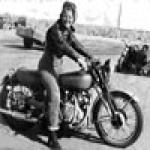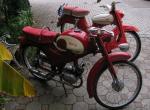-
Posts
368 -
Joined
-
Last visited
-
Days Won
5
Content Type
Profiles
Forums
Events
Gallery
Community Map
Posts posted by The Monkey
-
-
Neat shots on those bell mouths Tom! I did grab another lid in order to "adapt" an intake flow as I do have the larger intake valves and pistons ala Ferracci. Originally I intended to drill the lid but those bells make me want to pursue denser air from forward. Going to have to rethink it regarding ram-air uninfluenced by engine temperature. Cheers
-
Congratulations Boston! The best team and fan base (by far) did win. Damn good goalie.

-
I just measured the distance between registers and had a steel spacer made to match, sufficient scantling to ensure crush wasn't an issue. Stock one was .049 shy and was made of cheese! Previous owner had slipped in a washer .020!! Bizarre. No issues with steel spacer installed. Basic stuff when reassembling- lube the needle bearing on the drive side with bearing grease, (stick yer finger into the the bevel box and pop out the internal race to get at it) likewise the spindle (especially if your making a mild steel spacer), finally ensure the washer on the drive side is properly set into the recess, secure that with grease.

-
foto is always posting things I want to buy but can't, someday soon I'll get back, those new stelvios look fn great and have huge tanks
Whatever you ride, should have huge tanks. Makes it last that much longer

-
Good to see we aren't the only soggy lot! Bikes always look good in the wet, good riding the roads are freed up as all the who's stay indoors bemoaning the weather. Cool shoreline shots, kinda moody blue.

-
Keep an eye on the oil accumulation in the airbox, a little on the left is normal, too much indicates overfilling of the crankcase or excessive blow-by via the rings. The crank vent enters the airbox on the left side so you can expect a bit there. Pods do require a re-map as this leans things out considerably, if you ride in the rain this is not the way to go as the mill just becomes a waterpump. Stock airboxes work and work well, they are engineered to produce the most power given the legal requirements (noise, particulate) and are key when considering the exhaust in use. If you pod and free flow exhaust the machine you do shift more volume thru the process making more power but the benefit is realized only in a relatively small range of rpm. Upper RPM is impressive, but rideability for the street is drastically reduced. Last a K&N is designed to work "dirty" do a plug reading to check fuel to air. These bikes came lean initially, ensure your plugs are brown, not white, black or clean.
-
I dont mind the new look, forum layout is more inclusive regarding the other models. The update got rid of a lot of repetitive information. I struggled with it initially but now find it easier to use. Besides I am partial to the Moto Guzzi fairing (any of em) and I see more of them with the new skin. Like the gallery too. I'm no techy but change is the one constant we do have. Cheers

-
Good news! This issue sure throws my head for a loop, I run ethanol fuel more often than not. To protect what you have recovered maybe a liner like Kreem will keep the expansion bogeyman away from your bike. At any rate glad it came back, these tanks are too cool to toss out.

-
Excessive movement of the bevel box assembly on the axle indicates a shot needle bearing, #31 is the spacer/internal race inside the bearing (#30). It is easy to replace, any bearing shop can get the bearing/spacer for you. Or go pay twice as much thru Guzzi. Not a big job at all, use an expandable bearing puller (gently) and it'll pop right out and don't press the new one in any farther that it needs to go. Go easy it is a delicate item. Lube the needles and spacer with wheel bearing grease. After assembly wipe additional grease about the washer (#33) to keep moisture out.
Here are the numbers I have for Bearing HK2516RS and Race IR20x25x18 (IRZ)
The IRZ is an option on the race number, this just gets you one with a hole in it. Purpose of that hole is unknown but it seems like a fine path for moisture to find its way to the bearing. I haven't bothered with the hole version and its been fine for the last 40,000km. The ticket to long life on this unit is lube that needle bearing everytime you have the rear wheel off the machine. All that needle bearing itself does it support the nose end of the bevel box and allow rotational movement of the assemble on the axle as your rear suspension works. The internal race/spacer is part of the "stack" on the axle that comes tight with the axle nut. Hope that helps

-
Mine got significantly louder due to rivet failure, somehow managed to score the inner clutch hub and the friction plates would hang up on it, resulting in excessive noise and ultimately the failure of the remaining rivets rendering the clutch useless. Better get in there before more damage is done.
-
A classic example of Mandellarian mischievousness! Careless bastards. While producing the last of the line of beautiful motorcycles that came out of that little factory beside the lake- the question remains- Were the early 2000's the worst in 80 years regarding quality control? Maybe they were just broke and depressed, dutifully cobbling bikes together with what they had... whatever, if your shaft trunnions line up with the marks 90 degrees out then it is just a mismatch- redo the marks.
-
Simply a matter of ensuring each end of the shaft is operating in the same plane. You can do this by eye either assembled or disassembled. If its all together, turn the rear wheel so the shaft trunnion is straight up and down (12 and 6) look forward to the other end of the shaft and its trunnion, does it correspond. If it is at say 2 and 8 you need to pull the bevel box back and rotate so they do correspond. Keep in mind you either align each end of the shaft OR you align the bevel and transmission trunnion. While you're at it pop out the spacer (and washer if fitted) and put a little wheel bearing grease in the wee needle bearing located in the nose of the bevel box where it comes up against the swingarm. Use a marker and put your own alignment mark on the shaft for ease in the future. Hope that helps

-
Going to a different profile cam ie more lift less duration will give you more immediate power. It does in effect shorten the powerband forcing you to shortshift and with a lightened flywheel will help your greaser zip out of those corners. Other than that have a close ratio gear set made up and install em. Its only money right?

-
I remember Metzeler was recommending that the tires be inflated close to the max pressure. I think the minuses are obvious: colder tires means less grip; smaller contact patch; less shock absorbing. The pluses may be that they wear slower and they flex less so they keep their profile better. I may be wrong. Another thing I read was that the ideal cold pressure would go up by 5-10% after riding. More than 10% is to little pressure. So for this bike I had come up with 34 F and 38 R.
Makes sense. The manufacturer however does take the increase due to temp rise into account when suggesting a maximum pressure for the user. Now, the use of Nitrogen has given the retailer an excuse to go up into those realms when filling the tyre, resulting in a horrible ride if you accept that wheel as delivered, all in order to attain maximum life. I think we get caught up in the concept of ideal tyre performance- typical street rider having a field day comparing personal experiences to observed results made at tracks by lighter machines with considerably more power and lighter riders. What works so well there must work here...personally I have never had issues with a tyre not being warm enough as long as it is over 50F ambient. Its always been a matter of trying to cool the rubber down, but then again it depends on what you are doing- commuting, touring or scratching. I'm glad an outfit like Pirelli finally has an option for me and my Grand Tourismo Le Mans.
 oil and rubber eh? never ends
oil and rubber eh? never ends -
I'm thinkin of going to Pirelli for the next set of rubber. Pretty constant 11000-13000 kms on Bridgestone, Michelin and Metzeler but most riding is on a 2 lane twisty 120-140km/h. The quality of road is a factor but wear is more due to speed, ambient temperature, tyre pressure and the opportunity to keep moving the contact patch about the tyre. Good news is that all the major players are focusing on the sport touring tyre. Thats a bonus for any Guzzi unless you still have 18 inch rims. I run 36 psi up front and 42 rear minimum on a bike this heavy.

All girls are angels in the beginning. One day they may indeed make a tyre as tough as a girl.
-
Nice one Belfast. Pic #9 is a thing of beauty.
Cheers

-
I thought pit fighting was outlawed!
-
Kawi is getting a lot of use in the model range with that motor. cheap as Borscht! Park it anywhere and who cares whats missing when you get back. That sounds like a commuter bike. How is the used Triumph market down there? Their parallel twin is very refined and comes in a range of interesting bikes directed at the urban user.
-
Oil price is forecast to rise this summer! What can you do?
 I go about 250km before the fuel light kicks in and stop for fuel at around 325km. Sure see a lot of those monster motorhomes for sale beside the highway right now, maybe its time to buy land and plant one.
I go about 250km before the fuel light kicks in and stop for fuel at around 325km. Sure see a lot of those monster motorhomes for sale beside the highway right now, maybe its time to buy land and plant one. 
-
Having spent a frustrating morning in the garage pipe bending-burnt forearm! I'm no nearer that bloody nipple!!!!!!!!!!!!!! so I guess its wheel off, will the bevel and shaft just slide off? I have the alignment marks already on it, just line them up on re assembly? thanks
It is awkward and not all bikes seem to respond the same, but if the bike is on a stand so the rear is suspended and the grease zerk is at 12 oclock you do have a chance at getting a gun tip onto it. If you do disassemble the rear of the machine make sure the alignment marks are good (trunnions actually do line up) and reassemble with care.

-
My 2000 sport is sitting on 76,202 miles (122,635 Austrian kilometers)

just passed 16000 on my commute today
ye but its like 'triggers broom'!!! ten new heads and four handles!!!
Sorta demonstrates ya gotta ride it enough to bring the repair to mileage ratio within reason- dont it?

-
Hobby stores carry a wide choice of enamel colors in small bottles.

-
-
Gearbox oil can and will migrate to that seam via tired seals. Clear oil is likely gear oil (smells different too). Sounds like a slow leak and your clutch hasnt been affected yet so either ride it (keeping an eye on the level) till it does affect clutch performance or get the repair done before good weather riding or long trips. When the job is being done replace all seals/gaskets associated with engine and transmission that can possibly leak into the bell housing.
Try changing the transmission oil first. Some gear oils claim to have seal swelling qualities, stick with a proven brand and correct weight. This may delay the inevitable. Cheers





Rear Wheel Bearing Failure / Centerstand Questions
in Technical Topics
Posted
Thank you for clarifying Baldini, additionally when negotiating the front bearing set the spacer the bearing rides on (port side) is also made of inferior material, check it as it may need building up then turning to bring it up to the hardness required. How I came up with the measurement regarding material to use as a spacer is merely based upon experience. I chose steel as that was compliant with the rest of the metal in the "stack" aluminum would be twice the guage and bulky. Stainless is too soft, better to parkarize the steel. There is a great thread somewhere dealing with recommendation regarding crush and the axle spacer, look it up. Oh yeah pop out that bearing and measure space between registers and make damn good and sure the internal races aren't being squeezed due to a spacer too short!